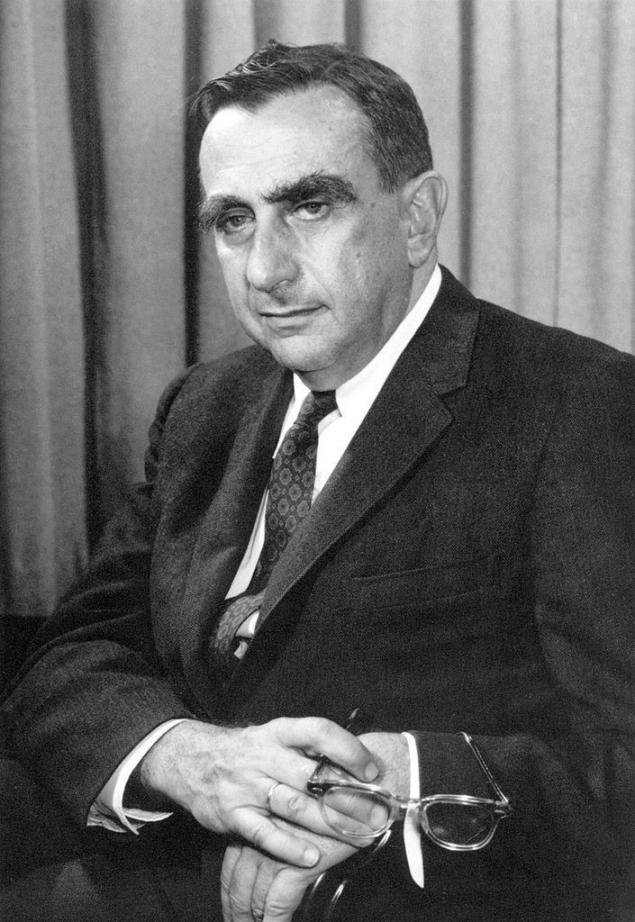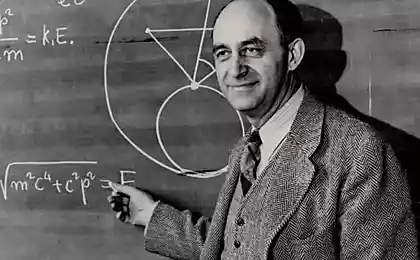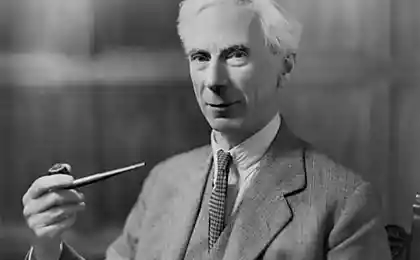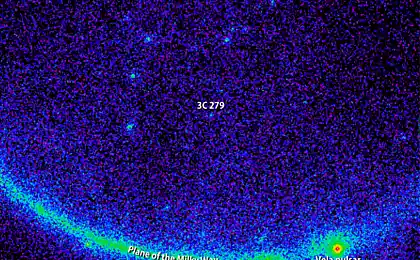628
How did the Fermi paradox

It's kind of a legend like Newton and the Apple. One day in 1950, the great physicist Enrico Fermi was having lunch with colleagues at the Fuller Lodge in Los Alamos national laboratory in new Mexico, and came to a powerful argument about the existence of extraterrestrial intelligence, the so-called "Fermi paradox". But like many legends, this is true only partly. Robert gray in the journal Astrobiology, told the real story.
Enrico Fermi received the Nobel prize in physics in 1938 and led the team that developed the world's first nuclear reactor at the University of Chicago. He has made important contributions to the Manhattan project to develop the atomic bomb during the Second world war. The Los Alamos laboratory where he worked, was the headquarters of the project.

Enrico Fermi
Arguments Fermi over lunch usually imagine this: in the milky Way galaxy there are many Earth-like planets. If intelligent life and technological civilization arises on one of them, in the end she invents interstellar travel. Colonize the nearest star system. The colony send a private colonization expedition, and this process will continue until every suitable planet in the galaxy will not be inhabited.
The fact that the Earth aliens there is a strong evidence that in galaxy either. This argument specifically does not belong to the Fermi, and was published 25 years later by astronomer Michael HART. Later disclosed in an article by cosmologist Frank Tobleron in 1980.
The conversation at dinner had taken place. Although only four years later he died of cancer, a physicist Eric Jones published memories of lunch companions, which took place over 35 years ago. Among them were Edward teller, Emil Konopinski and Herbert York, all eminent physicists and veterans of the Manhattan project. Teller played a Central role in the development of the hydrogen bomb. Konopinski studied the structure of the atomic nucleus, and York became Director of the Lawrence Livermore national laboratory.
During the walk to Fuller Lodge, physicists discussed the recent UFO wave signs, as well as the in the New Yorker Magazine depicting aliens and flying saucers. Although the topic of conversation changed, when the group stopped for lunch, Edward teller recalls that "in the middle of a conversation suddenly Fermi asked the question: where is everybody?". The answer to his questions was laughter, because despite the fact that the question came quite suddenly, all at once realized that he was talking about extraterrestrial life."
Recalling the famous lunch, teller wrote: "I do not believe that much came out of that conversation, except, perhaps, for the statement that the distances to the following places of residence of living beings may be too large, and we can be somewhere on the outskirts of the galaxy, far from the city center, the center of the galaxy."
York recalled and wider discussion, in which the Fermi "presented a series of calculations of the probability of earth-like planets, probability of life on Earth, the likelihood of human life, the likelihood of development and spread of high technology and so on. On the basis of these calculations he came to the conclusion that we had to visit many times."
According to York, Fermi suggested that the reason that we have not visited, "can be of the impossibility of interstellar flight, or, if it is possible, it is not worth the effort, or technological civilization has not existed long enough for that to happen".

Edward Teller
It turns out, Fermi, unlike HART, was not skeptical about the existence of aliens and did not consider their absence on Earth as a paradox. There is no Fermi paradox is simply a question of Fermi: where is everybody? And this question has many possible answers. The answer preferred by Fermi himself, there is that either interstellar travel is not possible due to huge distances, or the Wanderers of other worlds just never reached the Ground.

Herbert York
Interstellar distances are really huge. If the entire Solar system up to Neptune's orbit shrink to the size of a small quarter, the nearest star, Proxima Centauri will still be at the distance of a football field. In practice, the vehicle must either move very quickly, gaining a significant proportion of the speed of light, or have the opportunity to support their team for a very long time. Being possible in theory, interstellar travel seem modern man is too Grand a term, because it is not clear, will any civilization is to waste an extraordinary amount of resources for such travel.
When the same question Fermi began to be confused with the argument of HART? Carl Sagan referred to the question of Fermi in the notes to the article in 1963. After the publication of the work of HART in 1975, the Fermi question and speculative answer HART became associated in the minds of many. The Fermi question seemed to be asked the answer of the HART, and so was born "the Fermi paradox". According to Robert gray, this term was invented by D. Stevenson in the work published two years after the work of HART.
What is important in an argument that HART never brought physics Enrico Fermi? Contribution of Michael HART and Frank Tipler? Will reply to these questions.
"The Fermi paradox": the questions to the hypothesis of HART-Tipler overall, the legend of the space age turns out good. Prominent physicist Enrico Fermi during a lunch break at Los Alamos national laboratory in 1950 was seriously puzzled by the absence of extraterrestrial civilizations.
If aliens, travelling in space, there are, according to the argument, they had to spread into the galaxy and colonize every habitable world. And even the Earth. They should be here, but since they are not, it means that there is no such thing.
This argument became known as the "Fermi paradox". The problem is that, as we learned above, the Fermi never deduced. As I recall his companions for lunch (he Fermi died of cancer just four years later and never published on the topic of extraterrestrial intelligence), he just raised the question: where is everyone?
Fermi had no doubt that extraterrestrial civilizations may exist, but admitted that interstellar travel may be impossible, or the aliens just haven't found the Land in the vastness of the galaxy.
Argument, claiming that aliens do not exist, in fact, advanced by the astronomer Michael HART in the document, published in 1975. HART suggested that if extraterrestrials appeared in the galaxy, they would have invented interstellar travel and began to colonize the nearest stars. These colonies in turn started the colonization, until the entire galaxy was filled with the living.

How much time that one wave has spread across the galaxy? Assuming that the ships will travel at one-tenth the speed of light and upon arrival will take time for the construction of new ships, according to the calculations of HART, one wave traverses the galaxy in 650,000 years.
Even if you increase the time for consolidation of each colony to build new ships can cross the galaxy in 2 million years, and that tiny interval of space or evolutionary time scales. HART argues that because here on Earth, the aliens do not, and in the galaxy they are not.
HART's argument were expanded by the cosmologist Frank Tobleron in 1980. Tipler assumed that the alien colonists must enlist the help of a self-replicating robots. His findings were published in the article "Extraterrestrial intelligent beings do not exist".
Why is it important that the argument of HART has been formulated Enrico Fermi? Because the name Fermi may give the argument credibility, which it does not deserve. Supporters of the search for extraterrestrial intelligence (SETI) looking for evidence that aliens exist, listening to the radio the radio telescopes in search of messages that can be broadcast. The transmission of interstellar signals will be much cheaper than sending a ship, and the technology already exists.
HART drew the attention of state policy to your argument about the lack of extraterrestrial life. His paper concluded that "extensive search for radio messages from other civilizations is probably a waste of time and money."
Political leaders listened to the advice of HART. Senator William Proxmire successfully closed the financing of the SETI program in 1981, using the argument of HART-Tipler. The second attempt NASA SETI plan was drowned by Congress in 1993, and since then public funding of the search for extraterrestrial civilizations as such.
But how convincing is the hypothesis of HART-Tipler? Like HART, Carl Sagan was an optimist about the prospects of interstellar travel and has published its analysis of the consequences of interstellar travel, extraterrestrial intelligence ten years earlier than HART, in 1963. Sagan and his co-author, Russian astronomer Joseph Shklovsky, devoted an entire Chapter to this topic in his classic 1966 "Intelligent life in the Universe."
Like HART, Sagan came to the conclusion that "if you take the colonization of a rule, even one endearing space civilization would have spread much faster than it is galaxy, the milky Way. There would be colonies colonies colonies...". Why, Sagan, like HART, believes that aliens do not exist only because they have not visited Earth?

The answer is that Sagan, in contrast to HART, considered unlimited colonization by only one of the ways you may use extraterrestrial civilization. He wrote that "potentially habitable planets without technological civilizations will often be captured by the space travelers. It is unclear what will be their answer... Maybe a strict ban on the colonization of towns, but technically undeveloped planets will enter into a galactic Code. We are in no position to judge extraterrestrial ethics. Perhaps attempts to colonize all potentially habitable planets have already been made. Can be a great many intermediate cases."
In addition to the assumption that interstellar travel is feasible, the argument of HART there is a specific and risky idea of how aliens should behave. He suggested that they should adopt a policy of unlimited expansion, to expansionary quickly and, once the colony is established, to exist for millions or even billions of years. If any part of his argument about how aliens should behave is flawed, the argument of the existence of aliens will be destroyed.
Evolutionary biologist Stephen Jay Gould sharply criticized the reasoning of HART. He wrote that "I have to admit, I just don't know how to respond to such arguments. I find it difficult to predict the plans and reactions of people close to me. Me confusing thoughts and achievements of people of different cultures. I'll be damned if I can safely argue that can do some extraterrestrial source of intelligence."
In 1981, Sagan and planetary scientist William Newman has published a reply to HART and Tipler. Although HART used a very simple mathematical argument, assuming that an alien civilization needs to spread with the speed of its ships, Newman and Sagan used a mathematical model similar to those used by population biologists to analyze the distribution of animal populations, and tried to build a model of interstellar colonization.
They came to the conclusion that the pace of expansion, proposed by HART, is extremely unrealistic. Expansion will proceed at a diminished rate, for example, if civilization is to control the growth of population on a particular planet to avoid environmental collapse, if the colonies will have a limited lifespan, and if the alien community will eventually develop expansionist tendencies. HART's assumption that aliens will capture the galaxy at the speed of ships, is simply not tenable. You can get Rome for the day, noted by Newman and Sagan, but Rome was built much longer and grew more slowly.
If the evolution of intelligent life is the rule, other civilizations can emerge before the first hypothetical wave of expansion will reverberate through the galaxy. If some worlds will spawn a wave of colonization, they may face. What will happen then? Nobody knows. The history of the galaxy cannot be predicted from the two equations.
For Newman and Sagan, the absence of extraterrestrials on Earth doesn't mean they don't exist elsewhere in the galaxy and that they has never launched a spacecraft. It just means that they do not behave as expected HART. Scientists came to the conclusion that "except for the fact that we may, in the beginning of life in the galaxy, there is no old galactic civilizations established policy regarding the inhabited worlds; there is no galactic Empire."
It turns out Enrico Fermi's never had a powerful argument that extraterrestrial intelligence probably exists. And Michael HART didn't do it. The simple truth is that nobody knows whether there are aliens in this galaxy. If they exist, it is quite possible that the detected radio will provide us with the necessary evidence. And then we stop arguing and start to explore.published
Source: hi-news.ru























